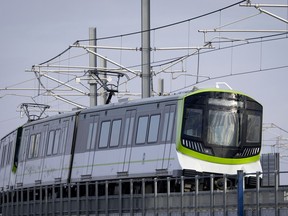“The fact there is a REM station will allow more people to leave their cars at home, but it also means there will be more pedestrians in the area,” said borough mayor Gracia Kasoki Katahwa.

A new bus line and two bike paths are on the drawing board as Montreal’s most populous borough begins the process of revamping the road network around the Canora and Édouard-Montpetit REM stations.
With a target of the fall of 2025 for that portion of the light-rail network to enter into service, the borough wants to make the neighbourhood around the future stations more pedestrian-friendly and safer for those walking and taking public transit. The targeted area is between Darlington and Wilderton Aves. to the west and east, and between Bates Rd. and Édouard-Montpetit Blvd. to the north and south.
“What we’re saying is that we’re going to stop developing the borough for others, and we’re going to make it safer for those who live there,” said Côte-des-Neiges—Notre-Dame-de-Grâce borough mayor Gracia Kasoki Katahwa.
The plan is for the borough to consult stakeholders including private and public schools, health institutions, Université de Montréal and the public at large.
“We are telling people we’re coming to talk to you over the next few months to speak about the future of the neighbourhood,” Katahwa said. “We know it’s important to speak with all the stakeholders before coming up with a final plan.”
The borough intends to unveil its plans for the road network’s reconfiguration by the beginning of 2026, at which point more public consultation sessions will be planned.
Among the potential developments are secure bike paths along Darlington and Wilderton Aves., which were already outlined in the city’s cycling plan, unveiled in 2019.
“But it’s not just for cyclists,” Katahwa said. “We’re going to be working to make it safer for pedestrians and even drivers, because they often have to do zigzags around people double parked and watch out for people passing from all sides.”
She said that from 2017 to 2021 there were 66 collisions between Van Horne Ave. and Bates Rd., with three serious injuries.
Société de transport de Montréal chair Éric Alan Caldwell said the transit agency will play a role in transforming the sector, as it plans to add a north-south bus line that will likely serve the Canora REM station. Caldwell could not give firm details on the eventual bus line, since the plans have not been finalized.
“The goal is to improve the offer, and with the arrival of a heavy mass transit service, this gives us a good opportunity,” he said.
The REM’s arrival is sure to have a great impact on the sector’s mobility, Caldwell said, as it will allow more people to come to the area — a major employment pole, with hospitals and a university — without having to rely on a car. It will also make it much faster to get downtown for those living near either REM station: it will take three minutes from Édouard-Montpetit and six from Canora to arrive at the McGill station.
“The fact there is a REM station will allow more people to leave their cars at home, but it also means there will be more pedestrians in the area, so we have to make sure that people can safely make the modal shift to transit,” Katahwa said.
Caldwell said the STM’s bus network will be reoriented around the REM. The plan for the neighbourhood — and all areas around REM stations — will be unveiled within a year.
“We’re in the process of doing that analysis right now and will come up with a reorganization that is likely to benefit everyone,” Caldwell said.